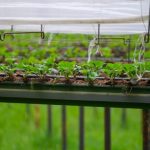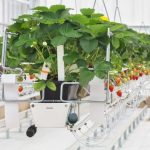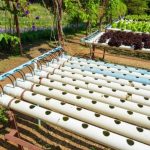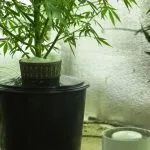In the vast world of hydroponics, Deep Water Culture system designs have emerged as a popular and beginner-friendly way to grow plants. If you’re new to hydroponics or looking to expand your knowledge, DWC is an excellent choice. It’s known for being cost-effective, easy to set up, and highly efficient in promoting plant growth.
DWC works by suspending plant roots in a well-oxygenated, nutrient-rich water solution that allows for optimal nutrient uptake. In a typical DWC system, you’ll find components such as a 5-gallon bucket, air pump, air stone, airline tubing, net pots, growing media, and appropriate hydroponic nutrients and pH control. Don’t worry about getting everything perfect from the start; it’s a learning process, and you’ll soon discover various system designs to suit your needs.
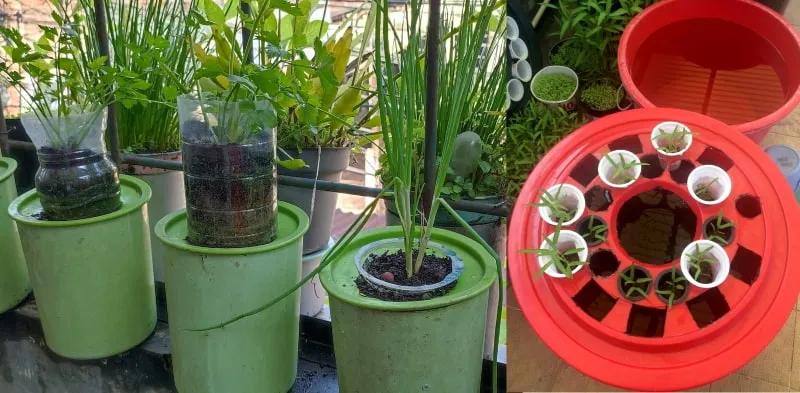
As you begin your journey with DWC, you’ll encounter various system designs, including traditional setups, dynamic raft-based methods, and hybrid systems. We’ll explain how each one works and then give you a step by step process to build a simple DIY deep water culture setup in your backyard or balcony. Your plants will benefit from the extra oxygen in the water, ensuring faster, stronger growth and healthier yields. Give DWC a try and witness the exciting potential of growing plants without soil!
Deep Water Culture System Designs
In this section, we’ll explore various Deep Water Culture (DWC) system designs that you can utilize in your hydroponic garden. We’ll focus on four main designs: Kratky Method, Traditional Method – The Raft System, Recirculating DWC, and Bubbleponics.
Kratky Method
The Kratky method is a passive, non-circulating DWC system, perfect for beginners. You don’t need any electrical components like air pumps or water pumps in this design. Simply follow these steps:
- Fill a container with water and mix in hydroponic nutrients.
- Adjust the pH level to 5.5-6.5 using a pH control kit.
- Place your plants in net pots filled with a growing medium like coco coir, perlite, or hydroton.
- Submerge the bottom of your net pots into the nutrient solution, ensuring only the lower roots touch the water.
As your plants grow, roots will reach down into the nutrient solution, taking up water and nutrients while the level of water recedes. The key is to make sure there is enough air in the container, allowing roots to access oxygen. If this sounds like the perfect system for you, we have a whole guide on its mechanics and how to make a Kratky hydroponic system.
Traditional Method – The Raft System
Now we come to the active methods of deep water culture. The Floating Raft System, one of the most popular DWC designs, uses air stones to provide aeration and circulation. To build this system:
- Fill a container with water and mix in hydroponic nutrients. A simple 5 gallon bucket is enough for a single plant.
- Adjust the pH level to 5.5-6.5 using a pH control kit.
- Place air stones in the container and connect them to an air pump via airline tubing.
- Plant your seedlings in net pots filled with growing medium and place them in circular cutouts on a styrofoam sheet. Place the sheet over the water container so that the bottom of the net pots are just an inch or 2 above the water line and the bottom of the roots of the plants are submerged in the water.
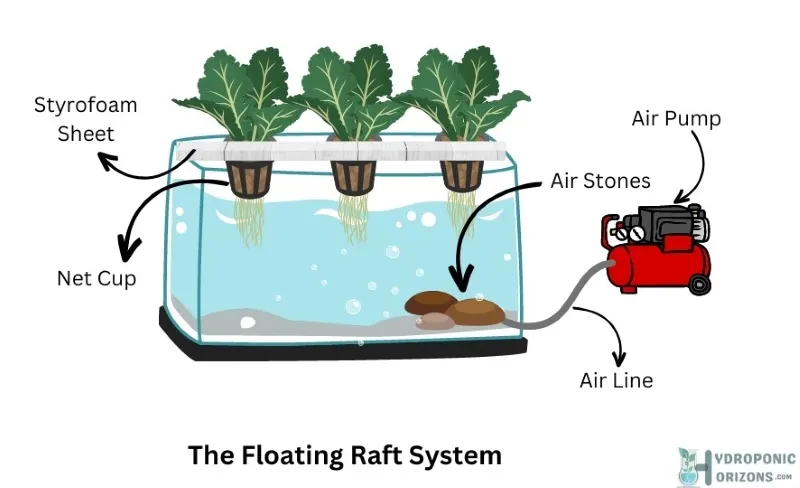
The air stones release fine bubbles into the water, supplying oxygen to roots and promoting nutrient absorption. Replace nutrient solution every 2-3 weeks to maintain optimal plant health.
Related: Read our detailed DWC hydroponics for beginner’s guide to understand the principles of this method.
Recirculating DWC
A recirculating DWC system circulates a nutrient solution between multiple containers. This design helps maintain consistent nutrient and pH levels and is suitable for larger gardens. Follow these steps:
- Set up multiple containers and fill them with water and hydroponic nutrients OR have a separate large reservoir filled with the nutrient solution in water. You should keep an eye on the DWC bucket water level using a level indicator and adjust the amount of nutrient-rich water in there as needed.
- Adjust the pH level of the entire setup to 5.5-6.5 using a pH control kit.
- Connect each container with tubes and use a submersible water pump in the main reservoir to circulate the nutrient solution between them.
- Incorporate air stones in each container and connect them to an air pump for aeration.
- Plant your seedlings in net pots filled with growing medium and place them in the containers.
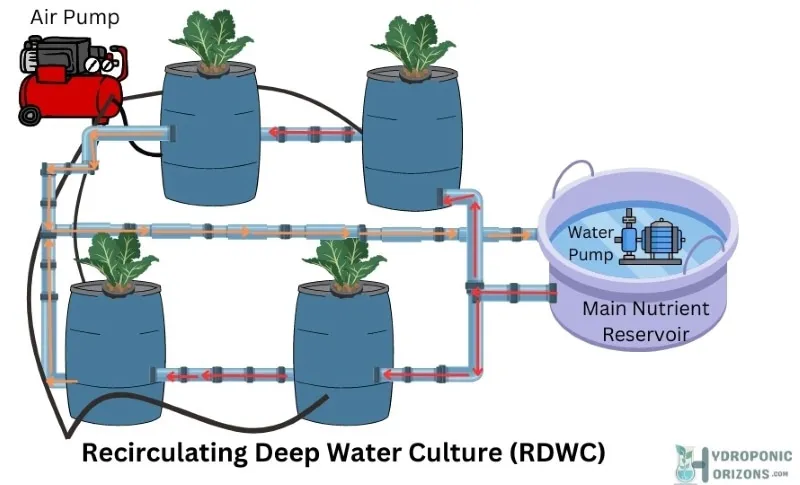
A fresh supply of nutrient-rich water is constantly fed to each container and what is not absorbed by the roots is recirculated back to the main reservoir where nutrients are constantly replenished as needed. Monitor the system regularly and replace the nutrient solution and adjust the pH as needed.
Related: Learn in detail the difference between DWC and RDWC systems and also the difference between RDWC and Dutch bucket systems.
Bubbleponics
Bubbleponics is a variation of DWC and the drip method that incorporates a water pump to deliver nutrient solution directly to the plant roots. The setup includes:
- A container with water, hydroponic nutrients, and a pH level of 5.5-6.5.
- Air stones and pumps for aeration.
- A submersible water pump connected to a drip line or manifold, directing nutrient solution to each plant.
- Net pots containing seedlings with a growing medium.
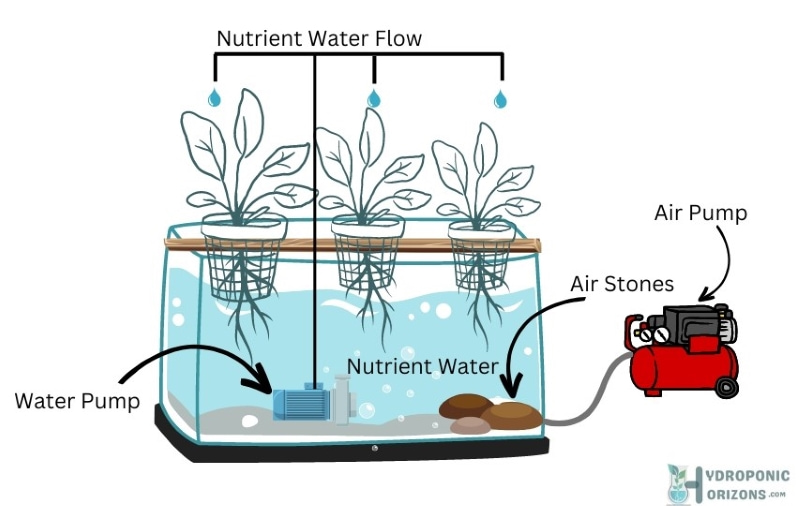
This design offers direct nutrient delivery and increased oxygen, resulting in faster, healthier plant growth during the initial stages when seedling roots may not be exposed enough to nutrient-rich water. Once the plant roots are of a good size, the drip line is no longer needed and the system can revert to a traditional DWC system.
Remember to keep your DWC systems clean and maintain proper nutrient and pH levels to reap the best results! Now that you know the different kinds of designs available in deep water culture, you can choose the best DWC bucket kit for your needs.
Scaling Up and Commercial Applications
Methods of Aeration
In deep water culture (DWC) systems, proper aeration is crucial for optimal plant growth. There are several common methods for achieving this in large-scale commercial applications. One popular method is air stones, which are porous stones connected to an air pump. These stones create fine bubbles that release oxygen into the water, ensuring your plants’ roots have access to sufficient dissolved oxygen. This is the best method for most hydroponic enthusiasts, as it’s simple and works well for small to moderate-sized gardens.

Falling water is another effective aeration method, which involves water cascading from a higher level in the system into the main nutrient reservoir. This falling action naturally increases the oxygen content of the water. It’s not a recommended aeration method for non-commercial growers, as it works best when the water falls into larger reservoirs. Additionally, commercial growers may use individual buckets or larger multi-gallon buckets to further enhance aeration, making it easier to scale up small systems.
Benefits for Commercial Growers
Scaling up and implementing advanced DWC systems can offer numerous benefits for commercial growers:
- Faster plant growth: DWC systems with adequate aeration or advanced techniques like aeroponics and NFT provide an optimal environment for faster plant growth and shorter production cycles.
- Higher yields: The constant access to oxygen and nutrients allows DWC systems to produce higher yields compared to traditional soil-based cultivation methods.
- Space efficiency: DWC systems can be designed in various stacking configurations that utilize vertical space, allowing commercial growers to maximize the use of the available area. Check out how stacked hydroponic systems compare to horizontal hydroponic setups.
- Water efficiency: Hydroponics and DWC systems typically consume less water than traditional soil-based cultivation, as water can be recirculated throughout the system.
- Scalability: DWC systems can be easily scaled up from small systems to larger commercial operations, making it an attractive option for hydroponic growers at various stages of business growth.
As you explore the possibilities of scaling up and implementing advanced deep water culture system designs, remember to carefully consider the appropriate methods of aeration and system types to maximize your commercial success.
DIY Small Deep Water Culture Set Up
Creating a Small System
When it comes to setting up a small DWC system, simplicity is the key. You will only need a few basic supplies and some creativity. By focusing on a single plant, you can achieve better yields while keeping your budget low. The main components of a DIY deep water culture system are a container, clay pebbles or an alternative grow medium, net pots, pipes or tubing, an air stone, and an air pump.
Choosing a Container
For a budget-friendly DWC setup, look for containers that are affordable and compact, such as a 5-gallon bucket. It should provide a sufficient size to allow your plant to have ample room for root growth and nutrient absorption.
Once you master this simple traditional DWC method for a single plant, you can slowly use a larger reservoir with several plants or add several interconnected reservoirs and additional equipment to scale your garden. Happy growing!

